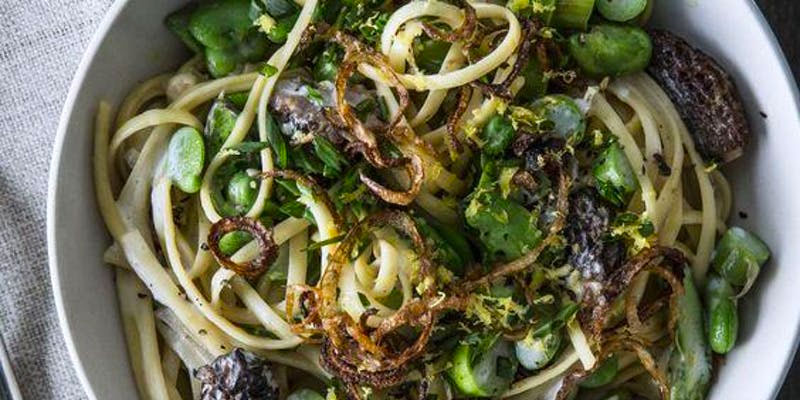May 14, 2019 – Recipe

The Greens
Basil is not necessarily the real reason why people love pesto. Admittedly it is a wonderful herb to use, when fresh and readily available. But what makes pesto great is the unique flavor combinations of fresh greens, toasted nuts, salty aged cheese, and grassy olive oil.
Instead of considering basil an essential, go with what is available. Check for the best fresh greens and herbs—and feel free to mix and match.
TRY WITH: parsley, cilantro, chervil, arugula, dandelion greens, broccoli, broccoli rabe, scallions, garlic scapes, ramp tops, kale, collards, mustard greens, radish tops, beet greens, spinach, watercress, or wild greens (yes, even fresh spring nettles).
The Nuts
You have our permission to never buy pine nuts again—they’re priced for hedge fund managers and, frankly, they are not worth the expense. There’s a whole world of tasty nuts and seeds out there that’ll add the rich earthiness that you’re after in your pesto. Whatever you decide to use, make sure to give your nuts or seeds a healthy toasting in the oven (and let them cool completely!)—which adds dark, roasted notes to your sauce.
TRY WITH: Walnuts, almonds, macadamia nuts, pecans, pistachios, sunflower seeds, pumpkin seeds, sesame seeds, or peanuts.
The Cheese
Parmesan lends a distinctive savory flavor to traditional basil pesto, but it isn’t your only option—any hard, salty, aged cheese (Italian or not) will work. If you’re interested in making a dairy-free pesto, you can go ahead and leave the cheese out, but be sure to increase the quantity of nuts and seeds to compensate.
TRY WITH: Romano, aged Manchego, aged Gouda, aged cheddar, aged Asiago.
The Other Stuff
Olive oil is traditional, for its great flavor. Lemon juice and zest are normally our go-to for brightening up an otherwise rich, low-tone sauce, but you could use any citrus or vinegar to balance flavors.
The garlic? Well, please just include the garlic. This is at least one part of the pesto tradition that shouldn’t be messed with.
Basic Pesto—to fit any season
- ½ cup chopped nuts (toasted and cooled)
- 3 cups spinach or any other greens or fresh herbs
- ½ cup parmesan cheese
- ½ cup extra-virgin olive oil
- 2 cloves garlic
- 1 teaspoon lemon juice
- 1 teaspoon salt/freshly ground pepper
- Roasted jalapen?o pepper, to taste (optional)
The pepper factor:? I also always add some roasted jalapen?o (chipotle) or cayenne to pesto for extra zing. You can go old-school and use a mortar and pestle.
Nettles Pesto—a truly economical pesto, especially for spring
- 6 cups of fresh nettle, blanched
- 2 garlic cloves
- Finely chopped ? cup nuts (toasted)
- ½ cup grated parmesan
- ? cup extra-virgin olive oil
- salt and freshly ground pepper, to taste
Notes about nettles: don’t be afraid of stinging nettles. When handled correctly, nettles can be used like basil to create all sorts of easy-to-make, tasty treats, including pesto.
Nettles are a “super-food,” an herb found growing in the wild in many places around the globe; its nutritional value is almost unmatched. One cup of nettles will provide 6.6 g of carbohydrates, 2.4 g of protein, between 7.7-17.5 percent of the daily recommended intake of iron, and its off the charts for vitamins K and A. Not bad for what many consider a weed!
Of course, there is one important caveat when considering the wonders of nettles: their stinging quality. Nettle leaves come with little hairs that sting when handled improperly. The best way to harvest them is to take the youngest leaves and pinch them off at the base while wearing gloves. You can then blanch them in boiling water for 30 seconds to remove the stingers.
